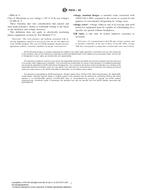We need your consent to use the individual data so that you can see information about your interests, among other things. Click "OK" to give your consent.
ASTM F2522-12
Standard Test Method for Determining the Protective Performance of a Shield Attached on Live Line Tools or on Racking Rods for Electric Arc Hazards
STANDARD published on 1.10.2012
The information about the standard:
Designation standards: ASTM F2522-12
Note: WITHDRAWN
Publication date standards: 1.10.2012
SKU: NS-54060
The number of pages: 8
Approximate weight : 24 g (0.05 lbs)
Country: American technical standard
Category: Technical standards ASTM
The category - similar standards:
Annotation of standard text ASTM F2522-12 :
Keywords:
cone of protection, effective heat attenuation factor (EHAF), heat attenuation factor (HAF), protective performance of a shield, shield mechanical strength (SMS) value, ICS Number Code 13.260 (Protection against electric shock. Live working)
Additional information
| Significance and Use | ||||
|
5.1 This test method is intended for determining the heat attenuation factor (HAF) of a shield material and the effective heat attenuation factor (EHAF) at the location of the worker. This can be obtained by measuring the reduction of the arc incident energy levels caused by a shield attached on a live line tool (hot stick) or on a racking rod and designed for protection for workers exposed to electric arcs. The shield mechanical strength (SMS) can be obtained from visual observations of the high speed video recordings of each shot during HAF tests. 5.1.1 Because of the variability of the arc exposure, different heat transmission values and pressure may result for individual sensors. The results of each sensor are evaluated in accordance with Section 12. 5.2 This test method maintains the shield and the heat sensors in a static, vertical position and does not involve movement except that resulting from the exposure. 5.3 This test method specifies a standard set of exposure conditions. Different exposure conditions may produce different results. 1.1 This test method is used to
determine the heat attenuation factor (HAF), the effective heat
attenuation factor (EHAF), and the shields mechanical strength
(SMS) of a shield attached on live line tools or racking rods
intended for protection of workers exposed to electric arcs.
1.2 The materials used in this test method of worker protection are in the form of a shield attached on live line tools or on the racking rods. 1.3 The protective shield described in this test method shall be transparent and shall be easily attached and removed from live line tools or from racking rods. 1.4 The protective shield described in this test method has 24-in. (0.61-m) diameter and can be used for most applications, however for special cases, the shield can have different sizes to suit the protective requirements of the application. 1.5 This standard shall be used to measure and describe the properties of materials, products, or assemblies in response to incident energies (thermal-convective, and radiant and pressure wave) generated by an electric arc under controlled laboratory conditions and does not purport to predict damage from light, resultant pressure impact other than the pressure and thermal aspects measured. 1.6 The values stated in inch-pound units are to be regarded as standard. The values given in parentheses are mathematical conversions to SI units that are provided for information only and are not considered standard. 1.7 This standard shall not be used to describe or appraise the fire hazard or fire risk of materials, products, or assemblies under actual fire conditions. However, results of this test may be used as elements of a fire assessment, which takes into account all of the factors, which are pertinent to an assessment of the fire hazard of a particular end use. 1.8 This standard does not
purport to address all of the safety concerns, if any, associated
with its use. It is the responsibility of the user of this standard
to establish appropriate safety and health practices and determine
the applicability of regulatory limitations prior to use.
Standard Test Method for Determining the
Arc Rating of Materials for Clothing Standard Terminology Relating to The
Burning Behavior of Textiles (Includes all amendments and changes
3/10/2022). |
Similar standards:
Historical
1.12.2011
Historical
1.4.2014
Historical
1.4.2011
Historical
1.11.2013
Historical
15.11.2011
Historical
1.4.2010
We recommend:
Technical standards updating
Do you want to make sure you use only the valid technical standards?
We can offer you a solution which will provide you a monthly overview concerning the updating of standards which you use.
Would you like to know more? Look at this page.



 ASTM F479-06(2011)..
ASTM F479-06(2011).. ASTM F496-14
ASTM F496-14 ASTM F696-06(2011)..
ASTM F696-06(2011).. ASTM F711-02(2013)..
ASTM F711-02(2013).. ASTM F712-06(2011)..
ASTM F712-06(2011).. ASTM F819-10
ASTM F819-10
 Cookies
Cookies
